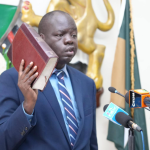- The government warned of heavy rains and flood
- Internal Security Minister Kipchumba Murkomen outlined strategies for flooding, including early alert systems, drainage improvement and emergency response protocols
- The government also allocated KSh 40 million for disasters and emergency response in this financial year, and plans to collect more resources if needed
- Murkomen emphasized public mobilization and co -operation of stakeholders, calling on residents in flood -affected areas to obey warnings and provide cooperation
Nairobi – The government has issued a warning about the possibility of heavy rainfall and floods in the coming months, especially in the counties KisumuBusia and Tana River.
Source: Facebook
Minister of Interior Kipchumba Murkomen He has assured the public that the government is fully prepared to handle the expected effects of the rainy season, which is expected to be close to normal in some regions.
During the Senate session on Wednesday, March 5, Murkomen outlined the steps the government has put to reduce the impact of the flood, including the introduction of an emergency counter.
What is the weather forecast of the weather department
The minister revealed that the Kenyan weather department predicted that the March to May 2025 rainy season would bring about a normal high rainfall in the western part of the country, with low rains expected in other areas.
This prediction has raised concerns about the possibility of flooding in flooding areas, especially Kisumu counties, Busia and Tana River.
Murkomen, responding to the question of Senator Beatrice Ogolla, confirmed that these three counties have been identified as dangerous areas of the flood.
He emphasized that the government has already implemented early alert systems and measures to prepare to address the expected challenges.
“The three -month weather forecast issued by the Kenya Climate Department in March, April and May 2025 shows almost the rains of the highest rains in the western region of the country and less common in other parts of the country. He said.
https://www.youtube.com/watch?v=k5ru-qftu8k
What strategies has Murkomen put in place
The interior minister explained in detail the government's strategies for the flooding, which includes preventative and responding measures.

Source: Twitter
He explained that the strategies aim to reduce the impact of flooding and ensure immediate action.
“The government has used flooding strategies, as well as others, to reduce the possibility of flooding. Following strategies, among others, reducing against potential floods, one, promoting deforestation and soil conservation, road repairs, food purchases and non -food products in preparing for the season, encouraging emergency efforts, improving stakeholder awareness. Effective in the event of a flood, including rescue protocols in the event of flooding and promoting cooperation between stakeholders to develop coordination of flooding events, ” Murkomen said.
How much has the government allocated for an emergency
In order to strengthen its readiness, the government has allocated KSh 40 million for disasters and emergency in this financial year.
Murkomen assured the Senate that additional resources would be collected if needed to handle any emergency arising from heavy rainfall.
“About how much has been allocated to 2024-2025, in this financial year, the Ministry has allocated KSh 40 million for disaster and emergency. He said.
Murkomen emphasized the importance of public mobilization and stakeholders' cooperation in reducing flood impact.
He called on residents in flood -affected areas to focus on government warnings and cooperate with the authorities when relocating and providing assistance.
The weather expert warns Kenyans
At the end of February, the Kenyan weather department issued a warning about extreme temperatures across the country.
The weather expert explained that daytime temperatures will exceed 30 ° C in many regions, while areas such as Central Kenya, Rift Valley, South-East Highlands, and Lake Valley Victoria may have less cold temperatures between 25 ° C and 30 ° C.
The department advised Kenyans to stay with water, reduce outdoor operations during extreme heat, and wear air -free clothes to prevent heat -related diseases.
Read English version
Do you have an exciting information that you would like to publish? Please, contact us via news@tuko.co.ke or WhatsApp: 0732482690.
Source: TUKO.co.ke













